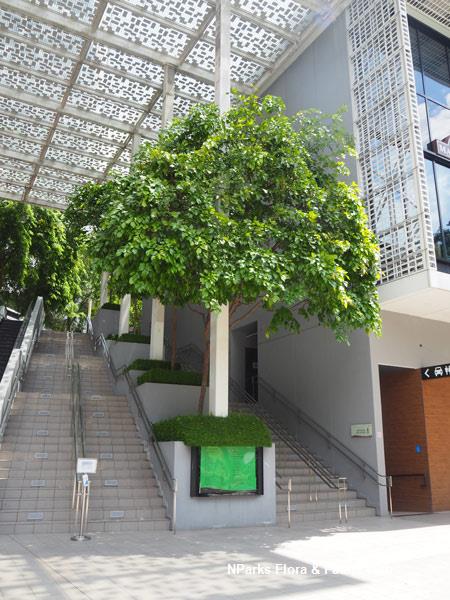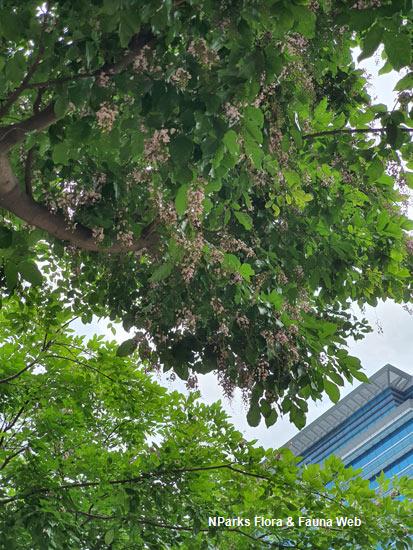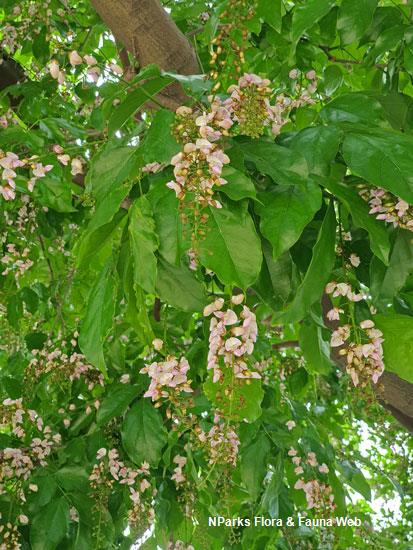
Back
Millettia pinnata (L.) Panigrahi
| Family Name: | Fabaceae (Leguminosae) |
| Synonyms: | Pongamia pinnata (L.) Pierre, Pongamia glabra Vent. |
| Common Name: | Seashore Mempari, Pongam, Indian Beech, Poonga Oil Tree, Karum Tree, 水黄皮, 番龙眼 |
Millettia pinnata is a tree that grows along rocky and sandy shores, and in mangrove forests. Its flowers are pink to white and fragrant too. After pollination by insects, a pale brown fruit pod is formed. The seed inside contains pongam oil that is used as an illuminant.
Name
Classifications and Characteristics
| Plant Division | Angiosperms (Flowering Seed Plants) (Dicotyledon) |
|---|---|
| Plant Growth Form | Tree (Medium (16m-30m)) |
| Lifespan (in Singapore) | Perennial |
| Mode of Nutrition | Autotrophic |
| Plant Shape | Broad / Mushroom / Hemispherical |
| Maximum Height | 15 m to 25 m |
Biogeography
| Native Distribution | Indian Ocean Islands (Mauritius, Reunion, Andaman and Nicobar), Indian Subcontinent, Sri Lanka, Southern China, Taiwan, Japan, Vietnam, Thailand, Philippines, Malaysia, Singapore, Indonesia, Papua New Guinea, Australia (Northern Territory, Queensland), Pacific Islands (Micronesia, Fiji) |
|---|---|
| Native Habitat | Terrestrial (Coastal Forest, Riverine), Shoreline (Sandy Beach, Mangrove Forest, Rocky Beach) |
| Preferred Climate Zone | Tropical, Sub-Tropical / Monsoonal |
| Local Conservation Status | Native to Singapore (Endangered (EN)) |
Description and Ethnobotany
| Growth Form | It is a semi-deciduous tree up to 25 m tall, with a dense, shining, light green crown. |
|---|---|
| Foliage | Its spirally arranged, stalked, pinnate leaves are 15–30 cm long. Each leaf has 1–3 pairs of opposite leaflets and a terminal leaflet. The thinly leathery to leathery leaflet blades are egg-shaped, oval or oblong, pink when young, dark green when mature, and 5–23 by 2.5–15 cm. Leaves shed periodically. |
| Flowers | The plant produces bisexual flowers. Its stalked flowers are fragrant, pink or white, 1.9 cm long, and occurring in pairs along the stalks of flower clusters that are 6–27 cm long and located in the leaf-axils. |
| Fruit | Its fruit is a pale brown pod, flat but thick, oblong, 3.8–7 by 1.5–5 cm, and each with a beak at its end. Each pod usually contains 1 seed that is 3.5–5 cm long. |
| Habitat | It can be found on rocky and sandy shores, and in mangrove forests. It occurs locally in Pulau Pawai, Pulau Tekong and Pulau Ubin, and is cultivated. |
| Associated Fauna | Its flowers are insect-pollinated. |
| Cultivation | It can be propagated by seed. |
| Etymology | Latin Pongamia, from the Malabar plant name, pongam; Latin pinnata, referring to the species’ pinnate leaves |
| Ethnobotanical Uses | Medicinal: The seeds produce pongam oil that is used as an illuminant and has medicinal properties. The juice of the leaves, shoots and bark is used as traditional medicine. Others: The seeds and roots are used as fish poison. The leaves can be used to feed cows. The bark is fibrous and can be used to make strings and ropes. |
Landscaping Features
| Landscaping | It may be suitable for parks and roadsides as it is a coastal plant that can tolerate high temperature, full sun, and frequent salt spray conditions. |
|---|---|
| Desirable Plant Features | Ornamental Flowers, Fragrant (Flowers) |
| Landscape Uses | General, Suitable for Roadsides, Coastal, Parks & Gardens, Small Gardens, Shade Providing Tree / Palm |
| Thematic Landscaping | Economic Garden, Naturalistic Garden |
Fauna, Pollination and Dispersal
| Pollination Method(s) | Biotic (Fauna) |
|---|---|
| Seed or Spore Dispersal | Abiotic |
Plant Care and Propagation
| Light Preference | Full Sun |
|---|---|
| Water Preference | Moderate Water |
| Plant Growth Rate | Moderate |
| Rootzone Tolerance | Fertile Loamy Soils, Waterlogged Soils (Drains Site), Saline Soils / Salt Spray, Moist Soils |
| Maintenance Requirements | Moderate |
| Propagation Method | Seed |
Foliar
| Foliage Retention | Drought / Semi-Deciduous |
|---|---|
| Mature Foliage Colour(s) | Green |
| Mature Foliage Texture(s) | Glossy / Shiny, Leathery, Thin |
| Prominent Young Flush Colour(s) | Red, Pink |
| Foliar Modification | Stipule |
| Foliar Type | Compound (Odd-Pinnate) |
| Foliar Arrangement Along Stem | Alternate |
| Foliar Attachment to Stem | Petiolate |
| Foliar Shape(s) | Non-Palm Foliage (Ovate, Oval, Oblong) |
| Foliar Venation | Pinnate / Net |
| Foliar Margin | Entire |
| Leaf Area Index (LAI) for Green Plot Ratio | 4.0 (Tree - Dense Canopy) |
Non - Foliar and Storage
| Trunk Type (Non Palm) | Woody |
|---|---|
| Bark Colour(s) | Grey, Greyish- Brown |
| Stem Type & Modification | Woody |
| Root Type | Underground (Tap Root, Fibrous Root) |
Floral (Angiosperm)
| Flower & Plant Sexuality | Bisexual Flowers |
| Flower Colour(s) | Pink, White |
|---|---|
| Flower Grouping | Cluster / Inflorescence |
| Flower Location | Axillary |
| Inflorescence Type | Raceme |
| Flowering Habit | Polycarpic |
Fruit, Seed and Spore
| Mature Fruit Colour(s) | Brown |
|---|---|
| Fruit Classification | Simple Fruit |
| Fruit Type | Dehiscent Dry Fruit , Legume / Pod |
Image Repository
Others
| Master ID | 1734 |
|---|---|
| Species ID | 3027 |
| Flora Disclaimer | The information in this website has been compiled from reliable sources, such as reference works on medicinal plants. It is not a substitute for medical advice or treatment and NParks does not purport to provide any medical advice. Readers should always consult his/her physician before using or consuming a plant for medicinal purposes. |









